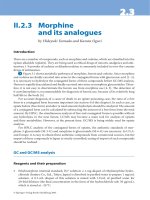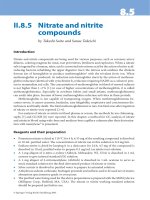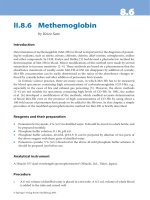Carnivore Ecology and Conservation: A Handbook of Techniques pptx
Bạn đang xem bản rút gọn của tài liệu. Xem và tải ngay bản đầy đủ của tài liệu tại đây (4.76 MB, 508 trang )
Carnivore Ecology and Conservation
OUP CORRECTED PROOF – FINAL, 6/12/2011, SPi
Techniques in Ecology and Conservation Series
Series Editor: William J. Sutherland
Bird Ecology and Conservation: A Handbook of Techniques
William J. Sutherland, Ian Newton, and Rhys E. Green
Conservation Education and Outreach Techniques
Susan K. Jacobson, Mallory D. McDuff, and Martha C. Monroe
Forest Ecology and Conservation: A Handbook of Techniques
Adrian C. Newton
Habitat Management for Conservation: A Handbook of Techniques
Malcolm Ausden
Conservation and Sustainable Use: A Handbook of Techniques
E.J. Milner-Gulland and J. Marcus Rowcliffe
Invasive Species Management: A Handbook of Principles and Techniques
Mick N. Clout and Peter A. Williams
Amphibian Ecology and Conservation: A Handbook of Techniques
C. Kenneth Dodd, Jr.
Insect Conservation: A Handbook of Approaches and Methods
Michael J. Samways, Melodie A. McGeoch, and Tim R. New
Remote Sensing for Ecology and Conservation: A Handbook of Techniques
Ned Horning, Julie A. Robinson, Eleanor J. Sterling, Woody Turner, and Sacha Spector
Marine Mammal Ecology and Conservation: A Handbook of Techniques
Ian L. Boyd, W. Don Bowen, and Sara J. Iverson
Carnivore Ecology and Conservation: A Handbook of Techniques
Luigi Boitani and Roger A. Powell
OUP CORRECTED PROOF – FINAL, 6/12/2011, SPi
Carnivore Ecology and
Conservation
A Handbook of Techniques
Edited by
Luigi Boitani
and
Roger A. Powell
1
OUP CORRECTED PROOF – FINAL, 6/12/2011, SPi
3
Great Clarendon Street, Oxford OX2 6DP
Oxford University Press is a department of the University of Oxford.
It furthers the University’s objective of excellence in research, scholarship,
and education by publishing worldwide in
Oxford New York
Auckland Cape Town Dar es Salaam Hong Kong Karachi
Kuala Lumpur Madrid Melbourne Mexico City Nairobi
New Delhi Shanghai Taipei Toronto
With offices in
Argentina Austria Brazil Chile Czech Republic France Greece
Guatemala Hungary Italy Japan Poland Portugal Singapore
South Korea Switzerland Thailand Turkey Ukraine Vietnam
Oxford is a registered trade mark of Oxford University Press
in the UK and in certain other countries
Published in the United States
by Oxford University Press Inc., New York
# Oxford University Press 2012
The moral rights of the author have been asserted
Database right Oxford University Press (maker)
First published 2012
All rights reserved. No part of this publication may be reproduced,
stored in a retrieval system, or transmitted, in any form or by any means,
without the prior permission in writing of Oxford University Press,
or as expressly permitted by law, or under terms agreed with the appropriate
reprographics rights organization. Enquiries concerning reproduction
outside the scope of the above should be sent to the Rights Department,
Oxford University Press, at the address above
You must not circulate this book in any other binding or cover
and you must impose the same condition on any acquirer
British Library Cataloguing in Publication Data
Data available
Library of Congress Cataloging in Publication Data
Library of Congress Control Number: 2011938082
Typeset by SPI Publisher Services, Pondicherry, India
Printed and bound by
CPI Group (UK) Ltd, Croydon, CR0 4YY
ISBN: 978–0–19–955852–0 (Hbk.)
978–0–19–955853–7 (Pbk.)
13579108642
OUP CORRECTED PROOF – FINAL, 6/12/2011, SPi
Foreword
Animals that must hunt and kill for at least part of their living are inherently
interesting to many people. Perhaps that is because humans evolved to make our
living that way as well, and carnivores often compete with us to this very day.
Wolves, bears, lions, tigers, leopards, lynx, mink, weasels, and foxes, and a wide
variety of their relatives, have long grabbed the human imagination. In any case,
carnivores comprise a very significant contingent of the world’s wildlife, and many
books have been written about them.
This book is distinct from its predecessors primarily through its emphasis on
techniques for dealing with carnivores: how to sample them, capture them for study,
handle them, monitor them, and even how to help minimize their competition with
us. It is a very helpful book that fills an important niche and comes at the right time.
In many parts of the world carnivores are persecuted, while in other parts they
are being restored. Thus societies remain interested in carnivores for one reason or
another, and science serves society’s interest through numerous carnivore studies.
The authors of this book’s chapters have conducted a significant proportion of
those studies for many years, and the editors for even longer.
Both editors are well qualified to produce this book, having studied and worked
with carnivores and their conservation for decades. I had the great opportunity of
partnering with Luigi Boitani in 1974, early in his career, when we spent a month in
Italy’s Abruzzo Mountains live-trapping, radio-collaring, and tracking wolves. I had
presented my paper “Current Techniques in the Study of Elusive Wilderness
Carnivores” at the Eleventh International Congress of Game Biologists in Stock-
holm in September 1973. It covered my experiences live-trapping and radio-
tracking wolves, fishers, martens, and lynxes as well as a literature review of current
techniques used to study other carnivores. I like to think of that paper as a germ that
helped spawn the present book. Luigi attended the Stockholm meeting, sought to
apply my techniques with wolves in Italy, and asked me to join him there to get
started. I eagerly agreed. Little did I realize then that 40 years later, Luigi and Roger
Powell would devote a whole book to techniques for studying carnivores.
During the same general period when I met Luigi, I also met Roger Powell.
Roger had joined my research team as a summer intern on a wolf–deer project in
the Superior National Forest of Minnesota, where we had also been radio-tracking
lynx, martens, and fishers on the side. The duties clearly agreed with him, for a few
OUP CORRECTED PROOF – FINAL, 6/12/2011, SPi
years later he began his own carnivore study, this one involving fishers. That study
became his dissertation topic, and I became one of his advisors.
That was all long ago, and the field has advanced greatly and blossomed. Now
instead of merely locating an animal via telemetry (a feat in itself years ago), one
searches the profuse literature, decides on study objectives, carefully plans the
study’s design, and chooses from any of the many high-tech radio-collars on the
commercial market that will best serve the objectives.
However, dealing with the most appropriate technology to study carnivores is
only a small part of carnivore investigations now. The data currently obtainable has
opened many new carnivore research vistas, and Boitani and Powell and their
collaborators have assembled a set of chapters that nicely address that array. An
early chapter on carnivore surveys, for example, is basic, for such surveys are of
special importance, both spatially and temporally. In some areas and with some
species, just obtaining a general idea of numbers and distribution can be very
important. Mapping such distributions plays a major role in these studies, and
non-invasive sampling is particularly valuable, especially with endangered or rare
species and in inaccessible areas. These subjects are well covered in this book.
In some areas of the world and with certain carnivores, detailed counts are
required annually. Sometimes with such counts it is valuable to estimate various
demographic parameters, and radio-telemetry often facilitates those estimates. To
collar carnivores, it is necessary to capture and handle them, allowing considerable
amounts of valuable data to be collected at that time. Once a carnivore is radio-
collared, data can be obtained about its movements, activity, home range or
territory, and dispersal. Often data about the creature’s predation and food habits
can also be collected, as well as information about its reproductive behavior. Several
chapters of this book deal with these subjects.
A subsidiary type of information, not directly related to a collared carnivore’s
movements, involves cause-specific mortality, including that from intraspecific
strife and diseases. Learning all this basic ecological, physiological, and behavioral
information then greatly aids in deriving mitigation measures for minimizing
depredation on livestock and other conflicts with humans, as well as facilitating
methods of restoring carnivores, monitoring the results, and furthering conserva-
tion efforts. Addressing those issues further rounds out this fine compendium.
Thus all in all, this book, edited by Luigi Boitani and Roger Powell, will be of
great use not only to carnivore researchers, but also to wildlife biologists through-
out the world who deal with carnivores, and it should stand as a milestone in the
carnivore-ecology and techniques literature for many years to come.
L. David Mech
US Geological Survey and University of Minnesota, USA
OUP CORRECTED PROOF – FINAL, 6/12/2011, SPi
vi | Foreword
Contents
List of contributors xv
1. Introduction: research and conservation of carnivores 1
Luigi Boitani and Roger A. Powell
2. Designing carnivore surveys 8
Luigi Boitani, Paolo Ciucci, and Alessio Mortelliti
2.1 Challenges of surveying carnivores 10
2.2 Planning a survey 10
2.2.1 Fundamentals of survey design: establishing goals and objectives 11
2.2.2 Fundamentals of survey design: carnivore survey data 12
2.2.3 Fundamentals of survey design: sampling design, methods,
and protocols
13
2.2.4 Fundamentals of survey design: statistically formalizing
survey objectives
14
2.3 Dealing with false absence 15
2.3.1 The fast growing family of occupancy models 16
2.3.2 Assumptions of occupancy models: the importance of a
priori planning
16
2.3.3 Some practical issues 18
2.3.4 Designing an occupancy study 18
2.4 Key issues for developing a survey design 19
2.4.1 Target population and spatial extent of the survey 19
2.4.2 Attribute to measure 20
2.4.3 Sampling design 21
2.4.4 Sampling effort 25
2.4.5 Tackling system variability: measures of precision and
their meaning
26
2.4.6 Field methods 29
3. Mind the map: trips and pitfalls in making and reading
maps of carnivore distribution 31
Carlo Rondinini and Luigi Boitani
3.1 Maps based on expert knowledge 32
3.1.1 Geographic range maps 32
3.1.2 Deductive habitat suitability models (HSM) 33
OUP CORRECTED PROOF – FINAL, 6/12/2011, SPi
3.2 Maps based on species’ occurrence surveys 34
3.2.1 Types of data 34
3.2.2 Biological significance and time relevance 36
3.2.3 Extrapolating points to map the distribution of a population 38
3.2.4 Inductive HSM 42
3.2.5 Caveats and limitations of deductive and inductive HSM 45
4. Noninvasive sampling for carnivore s 47
Marcella J. Kelly, Julie Betsch, Claudia Wultsch, Bernardo Mesa, and L. Scott Mills
4.1 Methods of noninvasive sampling 48
4.1.1 Sign surveys 48
4.1.2 Genetic sampling 49
4.1.3 Camera-trap sampling 54
4.1.4 Endocrine/hormone sampling 55
4.2 Recent tools and advances in noninvasive sampling 56
4.2.1 Noninvasive DNA techniques 56
4.2.2 Using noninvasive DNA data 59
4.2.3 Data collection, handling, and analyses with remote cameras 62
4.2.4 Data collection, handling, and analyses for endocrine studies 65
4.3 Combining noninvasive and traditional approaches 67
4.3.1 Comparative approaches among noninvasive techniques 67
4.3.2 Combining traditional with noninvasive approaches 68
4.3.3 Data quality and integrity in noninvasive surveys 69
5. Humane and efficient capture and handling methods for carnivores 70
Gilbert Proulx, Marc R. L. Cattet, and Roger A. Powell
5.1 Mechanical capture methods 72
5.1.1 Traps and sets 72
5.1.2 Trapping efficiency 73
5.1.3 Humaneness 74
5.1.4 Traps and sets for specific carnivores 75
5.2 Use of drugs for capture and restraint of carnivores 78
5.2.1 Drug access, storage, and handling 78
5.2.2 Selection of drugs for use in carnivores 79
5.2.3 Methods to administer drugs 81
5.2.4 The value of knowledge and experience 81
5.3 Identification, prevention, and treatment of medical emergencies
associated with capture
84
5.3.1 Homeostasis, stress, distress, and treatment of medical emergencies 84
5.3.2 Necropsy 86
5.4 Euthanasia 86
5.5 Restraining and marking techniques 88
OUP CORRECTED PROOF – FINAL, 6/12/2011, SPi
viii | Contents
5.6 Designing effective trapping programs for carnivores 89
5.7 Animal welfare 89
Appendices 92
6. Carnivores in hand 130
Kerry R. Foresman
6.1 Aging 130
6.2 Standard body measurements 132
6.2.1 Body mass 133
6.2.2 Length measurements 133
6.2.3 Additional body measurements 136
6.2.4 Additional measurements, some to estimate age 137
6.2.5 Footpad patterns 137
6.3 Tooth eruption and measurements 137
6.3.1 Tooth eruption, wear, and age 138
6.3.2 Pulp cavity measurements and age 139
6.3.3 Cementum annuli and age 140
6.4 Skull and skeletal measurements 142
6.4.1 Skull measurements 142
6.4.2 Skull fusion and age 144
6.4.3 Skeletal morphology and age 144
6.4.4 Eye lens and age 144
6.5 Pelage and age 145
6.6 Sex and reproduction 145
6.7 Injuries 148
6.8 Physiological parameters 148
6.8.1 Blood 149
6.8.2 Tissue samples 149
6.8.3 Other samples 150
6.9 Bioelectrical impedance 150
6.10 Asymmetry 151
7. Radio-telemetry equipment and applicatio ns for carnivores 152
Mark R. Fuller and Todd K. Fuller
7.1 General background 152
7.2 Basic telemetry system 156
7.3 Radio-tracking field procedures 163
7.4 Satellite telemetry systems 163
7.5 Radio-telemetry applications for carnivores 166
OUP CORRECTED PROOF – FINAL, 6/12/2011, SPi
Contents | ix
8. Estimating demographic parameters 169
Ken H. Pollock, James D. Nichols, and K. Ullas Karanth
8.1 Combined challenges of carnivore ecology and survey logistics 170
8.2 Detection probabilities and demographic inference 171
8.3 Capture–recapture models 174
8.3.1 Closed models 175
8.3.2 Open models 177
8.3.3 Robust design models 178
8.3.4 Natural individual tags 178
8.3.5 Design of capture–recapture studies 180
8.4 Telemetry mortality models 180
8.4.1 Survival models 180
8.4.2 Combining telemetry and regular mark–recapture
models in one overall analysis
181
8.5 Occupancy models 181
8.5.1 Single-season models 181
8.5.2 Multi-season models 183
8.5.3 Software and study design 184
8.6 Probability sampling of carnivore tracks to estimate population density 185
8.7 Final thoughts 185
9. Movements, home ranges, activity, and dispersal 188
Roger A. Powell
9.1 Research design 189
9.2 Movements 191
9.3 Home range 193
9.4 Territories 196
9.5 Estimating animals’ home-ranges and territories 199
9.6 Home-range cores, overlap, and territoriality 208
9.6.1 Home-range cores 208
9.6.2 Home-range overlap 213
9.6.3 Static interactions 214
9.6.4 Dynamic interactions 215
9.6.5 Testing for territoriality 216
9.7 Parting thoughts 216
OUP CORRECTED PROOF – FINAL, 6/12/2011, SPi
x|Contents
10. Carnivore habitat ecology: integrating theory and application 218
Michael S. Mitchell and Mark Hebblewhite
10.1 What is habitat? 219
10.1.1 Potential, sink, quality, source, suitable, or critical?
What kind of habitat is it?
220
10.1.2 A fitness-based definition of habitat 222
10.2 What is carnivore habitat? 227
10.3 Measuring habitat use and selection by carnivores 232
10.3.1 The over-riding importance of questions 233
10.3.2 Why should carnivores be selective? 234
10.3.3 The importance of scale 236
10.3.4 Density dependence and habitat selection 237
10.3.5 Understanding habitat selection: study design 238
10.3.6 Using resource-selection functions and other approaches 240
10.3.7 Functional responses in resource selection 243
10.3.8 The importance of defining availability: recent advances
from the field of movement modeling
244
10.3.9 Quantifying resources 246
10.4 Linking habitat selection to population consequences 250
10.4.1 Habitat-based population estimates 251
10.4.2 Combining habitat and spatial models of mortality risk 252
10.4.3 Spatially explicit population models 253
10.5 Conclusions 255
11. Describing food habits and predation: field methods
and statistical considerations 256
Erlend B. Nilsen, David Christianson, Jean-Michel Gaillard, Duncan
Halley, John D.C. Linnell, Morten Odden, Manuel a Panzacchi,
Carole Toı
¨
go, and Barbara Zimmermann
11.1 Quantifying predators’ diets 256
11.1.1 Scat analysis 256
11.1.2 Analysis of partly digested food items 259
11.1.3 Snow- and sandtracking 259
11.1.4 Telemetry-based methods to study predator diet 260
11.2 Ecological inferences from diet data 262
11.2.1 Quantifying kill rates and functional responses 262
11.2.2 Studying selection—the difference between use and availability 264
11.2.3 Quantifying food niche breadth and diet overlap 266
11.3 Using stable isotopes to infer trophic interactions 267
11.4 Estimating non-lethal effects of predation 269
11.5 Some further challenges 271
OUP CORRECTED PROOF – FINAL, 6/12/2011, SPi
Contents | xi
12. Reproductive biolog y and endocrine studies 273
Cheryl S. Asa
12.1 Carnivore reproductive physiology: the basics 273
12.1.1 Puberty 273
12.1.2 Seasonal reproduction 275
12.2 Stages of the female reproductive cycle 276
12.2.1 Pregnancy 278
12.2.2 Delayed implantation or embryonic diapause 279
12.2.3 Seasonal and lactational anovulation 280
12.2.4 Frequency of ovarian cycles 280
12.3 The endocrinology of stress 280
12.4 Endocrine studies and sampling strategies 281
12.5 Sample collection 284
12.5.1 Blood 284
12.5.2 Urine 285
12.5.3 Feces 286
12.5.4 Saliva 288
12.5.5 Hair 288
12.6 Non-endocrine techniques for studying reproduction 289
12.6.1 Males 289
12.6.2 Females 289
12.7 Gamete preservation and assisted reproduction 291
12.8 Control of reproduction 292
13. Investigating cause-specific mortality and diseases in
carnivores: tools and techniques 294
Greta M. Wengert, Mourad W. Gabriel, and Deana L. Clifford
13.1 Determining causes of mortality in carnivores 294
13.1.1 Locating dead animals to determine cause-specific mortality 295
13.1.2 Handling dead animals and important precautions 296
13.1.3 Field-data collection at mortality sites 296
13.1.4 The clinical necropsy 297
13.1.5 When clinical necropsies just aren’t feasible—a
quick guide to field necropsy
298
13.1.6 Field and laboratory investigation of intraguild predation 298
13.2 Studying disease and pathogen cycles in carnivores 300
13.2.1 Detection of disease, infection, and pathogen exposure 300
13.2.2 Epizootiology in carnivore populations 305
13.2.3 Modeling techniques in disease ecology 308
13.3 Prevention and control of disease 310
13.3.1 Intervention options: removing the causative factor 310
13.3.2 Intervention options: manipulating the host population 310
OUP CORRECTED PROOF – FINAL, 6/12/2011, SPi
xii | Contents
13.3.3 Intervention options: manipulating sympatric species
including domestic animals
312
13.3.4 Intervention options: addressing human activities 313
14. Mitigatio n methods for conflicts associated with carnivore
depredation on livestock 314
John D. C. Linnell, John Odden, and Annette Mertens
14.1 Who kills whom? 315
14.2 Documenting depredation 315
14.3 The ecology of depredation and its mitigation 319
14.3.1 Avoiding encounters between carnivores and livestock 319
14.3.2 Preventing the recognition of livestock as potential prey 321
14.3.3 Preventing access to livestock by carnivores 324
14.4 Compensation 328
14.5 Integrating mitigation into agricultural policy 330
15. Carnivore restoration 333
Michael K. Stoskopf
15.1 Human dimension 334
15.1.1 Cultural issues 334
15.1.2 Political and jurisdictional issues 335
15.1.3 Economics 335
15.2 Environmental and habitat dimension 337
15.2.1 Topography 337
15.2.2 Climate 338
15.2.3 Anthropogenic features 339
15.2.4 Prey base 339
15.2.5 Health-risk assessment 339
15.3 Animal dimension 340
15.3.1 Carnivore–carnivore interactions 340
15.3.2 Carnivore-prey interactions 342
15.3.3 Selecting founder populations 342
15.3.4 Use of captive animals for restoration 342
15.3.5 Genetic management 344
15.3.6 Hybridization and introgression management 345
15.3.7 Health management and biosecurity 346
15.3.8 Health interventions 347
15.3.9 Adaptive management 348
15.3.10 Release methods 349
15.3.11 Population augmentation 350
15.4 Exit strategy 351
OUP CORRECTED PROOF – FINAL, 6/12/2011, SPi
Contents | xiii
16. Designi ng a monitoring plan 353
Eric M. Gese, Hilary S. Cooley, and Frederick F. Knowlton
16.1 Identifying questions and monitoring designs 354
16.2 Developing a monitoring program 355
16.3 Evaluating the monitoring plan 358
16.3.1 Thresholds and trigger points 358
16.3.2 Forecasting trends 359
16.3.3 Predicting patterns over space and time 359
16.3.4 Integrating monitoring data 360
16.3.5 Risk analysis 360
16.4 Changing the monitoring plan 360
17. Assessing conservation status and units for conservation 362
Urs Breitenmoser, Christine Breitenmoser-Wu
¨
rsten, and Luigi Boit ani
17.1 Assessing extinction risks for carnivore populations 363
17.2 Identifying and delineating carnivore conservation units 368
17.2.1 Choosing biological entities 368
17.2.2 Socio-political considerations 371
17.2.3 Geographic delineation 373
17.3 Designating and establishing carnivore conservation units 375
17.4 Final thoughts 378
References 379
Index 491
OUP CORRECTED PROOF – FINAL, 6/12/2011, SPi
xiv | Contents
List of contributors
Cheryl S. Asa Saint Louis Zoo, 1 Government Drive, St. Louis, MO 63110, USA.
E-mail:
Julie Betsch Wildlife Biology Program, Department of Ecosystem and Conservation
Sciences, University of Montana, Missoula, MT 59812 USA.
E-mail:
Luigi Boitani Department of Biology and Biotechnologies, Sapienza Università di Roma,
Viale dell’Università 32, 00185 Roma, Italy. E-mail:
Urs Breitenmoser Institute of Veterinary Virology, Vetsuisse Faculty, University of
Berne, Länggass-Strasse 122, CH-3012 Bern, Switzerland.
E-mail: h
Christine Breitenmoser-Wu
¨
rsten KORA, Thunstrasse 31, CH-3074 Muri,
Switzerland. E-mail:
Marc R. L. Cattet Canadian Cooperative Wildlife Health Centre, Western College of
Veterinary Medicine, University of Saskatchewan, 52 Campus Drive, Saskatoon,
Saskatchewan, S7N 5B4, Canada. E-mail:
Paolo Ciucci Dep artment of Biology and Biotechnologies, Sapienza Università di Roma,
Viale dell’Università 32, 00185 Roma, Italy. E-mail:
Deana L. Clifford California Department of Fish and Game, Wildlife Investigations Lab,
1701 Nimbus Road, Rancho Cordova, CA 95670, USA and Wildlife Health Center,
University of California, Davis, CA 95616, USA. E-mail:
Hilary S. Cooley US Fish and Wildlife Service, Idaho Fish and Wildlife Office, Boise,
ID 83709, USA. E-mail:
David Christianson Department of Ecology, Montana State University, 310 Lewis
Hall, Bozeman, Montana, USA. E-mail:
Kerry R. Foresman Division of Biological Sciences, The University of Montana,
Missoula, MT 59812, USA. E-mail:
Mark R. Fuller US Geological Survey, Forest and Rangeland Ecosystem Science Center,
and Boise Stat e University - Raptor Research Center, 970 Lusk St., Boise, Idaho
83706 USA. E-mail:
Todd K. Fuller Department of Environmental Conse rvation, University of
Massachusetts, 160 Holdsworth Way, Amherst, MA 01003-9285 USA.
E-mail:
OUP CORRECTED PROOF – FINAL, 6/12/2011, SPi
Mourad W. Gabriel Integral Ecology Research Cen ter, 102 Larson Heights Road,
McKinleyville, CA 95519 USA and Veterinary Genetics Laboratory, University of
California, Davis, 95616 USA. E-mail: mwgab
Jean-Michel Gaillard UMR CNRS 5558 “Biometrie et Biologie Evolutive”, Bât.
G. Mendel, Université Lyon 1, 43 boulevard du 11 novembre 1918, 69622
Villeurbanne Cedex, France. E-mail:
Eric M. Gese US Department of Agriculture, Wildlife Services, National Wildlife
Research Center, Department of Wildland Resources, Utah State University, Logan,
UT 84322-5230, USA. E-mail:
Duncan Halley Norwegian Institute for Nature Research, Tungasletta 2, NO-748 5
Trondheim, Norway. E-mail:
Mark Hebblewhite Wildlife Biology Program, Department of Ecosystem and
Conservation Sciences, University of Montana, Missoula, MT, 59812, USA.
E-mail:
K. Ullas Karanth Wildlife Conservation Society, Centre for Wildlife Studies, 26-2, Aga
Abbas Ali Road (Apt:403), Bangalore, Karn ataka-560042, India.
E-mail:
Marcella J. Kelly Department of Fish and Wildlife Conservation, 146 Cheatham Hall,
Virginia Tech, Blacksburg, VA 24061-0321. USA. E-mail: makell
Frederick F. Knowlton US Department of Agriculture, Wildlife Services, National
Wildlife Research Center, Department of Wildland Resources, Utah State University,
Logan, UT 84322-52 30, USA. E-mail:
John D.C. Linnell Norwegian Institute for Nature Research, Tungasletta 2, NO-7485
Trondheim, Norway. E-mail:
Annette Mertens Institute of Applied Ecology, Via B. Eustachio 10, 00161 Rome,
Italy. E-mail:
Bernardo Mesa Department of Fish and Wildlife Conservation, 318 Cheatham Hall,
Virginia Tech, Blacksburg, VA 24061-0321. USA. E-mail:
L. Scott Mills Wildlife Biology Program , Department of Ecosystem and Conservation
Sciences, University of Montana; Missoula, MT, 59812 USA.
E-mail:
Michael S. Mitchell US Geological Survey, Montana Cooperative Wildlife Research
Unit, 205 Natural Science Building, University of Montana, Missoula, MT 59812,
USA. E-mail:
Alessio Mortelliti Department of Biology and Biotechnologies, Sapienza Università di
Roma, Viale dell’Università 32, 00185 Roma, Italy.
E-mail:
OUP CORRECTED PROOF – FINAL, 6/12/2011, SPi
xvi | List of contributors
James D. Nichols Patuxen t Wildlife Research Center, 12100 Beech Forest Dr., Laurel,
MD 20708-4017, USA. E-mail:
Erlend B. Nilsen Norwegian Institute for Nature Research, Tungasletta 2, NO-7485
Trondheim, Norway. E-mail:
John Odden Norwegian Institute for Na ture Research, Tungasletta 2, NO-7485
Trondheim, Norway. E-mail:
Morten Odden Faculty of Forestry and Wildlife Management, Hedmark University
College, Evenstad, NO-2480 Koppang, Norway. E-mail:
Manuela Panzacchi Norwegian Institute for Nature Research, Tungasletta 2, NO-7485
Trondheim, Norway. E-mail:
Kenneth H. Pollock Centre for Fish and Fisheries Research, Murdoch University,
Murdoch, WA, Australia. E-mail:
Roger A. Powell, Department of Biology, North Carolina State University, Raleig h, NC
27695-7617, USA. E-mail:
Gilbert Proulx Alpha Wildlife Research & Management Ltd. , 229 Lilac Terrace,
Sherwood Park, Alberta, T8H 1W3 Canada. E-mail:
Carlo Rondinini Department of Biology and Biotechnologies, Sapienza Università di
Roma, Viale dell’Università 32, 00185 Roma, Italy.
E-mail:
Michael K. Stoskopf Department of Companion Animal and Special Species Medicine,
College of Veterinary Medicine, North Carolina State University, 4700 Hillsborough
St., Raleigh, North Carolina, 27606, USA. E-mail:
Carole Toı
¨
go ONCFS, 5 allée de Bethléem, ZI Mayencin, 38610 Gières, France.
E-mail:
Greta M. Wengert Integral Ecolo gy Research Cen ter, 102 Larson Heights Road,
McKinleyville, CA 95519 USA and Veterinary Genetics Laboratory, University of
California, Davis, CA 95616 USA. E-mail:
Claudia W ultsch Department of Fish and Wildlife Conservation, 318 Cheatham Hall,
Virginia Tech, Blacksburg, VA 24061-0321. USA. E-mail:
Barbara Zimmermann Faculty of Forestry and Wildlife Management, Hedmark
University College, Evenstad, NO-2480 Koppang, Norway.
E-mail:
OUP CORRECTED PROOF – FINAL, 6/12/2011, SPi
List of contributors | xvii
1
Introduction: research and conservation
of carnivores
Luigi Boitani and Roger A. Powell
This is a book about carnivores but, more so, it is a book about techniques for
studying carnivores. The emphasis is on the diverse ways that researchers and
managers study carnivores, from documenting presence and absence and counting
numbers; to studying individuals and populations remotely or interactively; to
understanding movements, habitat, physiology, and disease; to helping popula-
tions recover or limiting damage to livestock. The ways one can study carnivores
are as diverse as the carnivores themselves.
The diversity of carnivores contributes to the diversity of study techniques. The
Carnivora includes some 230+ species, the exact number depending on the species’
concept used and systematic techniques used to generate phylogenies. Carnivores
live throughout all continents except Antarctica, from sea level to > 5000 m (snow
leopards, Uncia uncia), and in all habitats, from deserts to rain forests, from tropics
to the arctic, and including densely populated urban areas. Although we often
associate carnivores with wilderness and remote areas, many have adapted to
human-made habitats. Some stone martens (Martes foina) live in dense urban
centers of some European cities, often resting in attics of houses and under the
hoods of cars. Raccoons (Procyon lotor) have colonized many North American
cities, also sometimes resting in attics but more often resting and denning in hollow
trees or, like striped skunks (Mephitis mephitis), under houses. In fact, except for
those that are strict specialists (e.g. giant pandas, Ailuropoda melanoleuca; black-
footed ferrets, Mustela nigripes), carnivores can be remarkably flexible in their use
of human-made habitats, depending on the level of persecution. Black bears (Ursus
americanus) make winter dens under people’s houses, wolves (Canis lupus) and
black and brown bears (Ursus arctos) scavenge in dumps, and tigers (Panthera tigris)
and polar bears (Ursus maritimus) sometimes hunt people in towns and villages.
The research used as examples in this book spans the diversity of carnivore habitats
OUP CORRECTED PROOF – FINAL, 6/12/2011, SPi
from areas with no permanent human inhabitants, through areas with various
levels of sparse human occupation, to areas with dense human populations and
highly altered habitats.
The diversity of carnivores, however, does not end with habitats. Carnivores
span over four orders of magnitude in weight, from female least weasels (Mustela
rixosa formerly Mustela nivalis) weighing less than 50 g to male polar bears reaching
600 kg. They vary similarly in densities, from urban racoons with densities
exceeding 100/km
2
to wolverines (Gulo gulo) and far northern bears (polar,
brown, and black) and wolves with home ranges of 100s to >1000s of km
2
.
And, while black-footed ferrets are recovering from a population low of 10
individuals and other carnivores are similarly endangered, small Asian mongooses
(Herpestes javanicus) are invasive on the West Indies and Hawaiian Islands.
Although “carnivore” means meat eater, members of the Carnivora have diets
that span the entire spectrum. Some are strict carnivores (many felids and muste-
lids), many scavenge, have some level of omnivory (canids to most ursids
and procyonids), or are insectivorous (some mongooses, canids, and aardwolves,
Proteles cristatus), and giant pandas are strictly vegetarian. For predatory carnivores,
hunting strategies include ambush, stalking, chasing, and hunting in groups.
Indeed, many carnivores are highly social and have highly complex social behaviors
and capabilities, to the extent that humans domesticated wolves to become dogs
(Canis familiaris), with which they have since coevolved.
The consequence of this “diverse diversity” of carnivores, and the diversity of
human relationships with carnivores, is that developing a book on techniques for
studying carnivores has been challenging. The diversity within the group is truly
astounding and makes generalizations nigh onto impossible, except, perhaps, for
one: in all their diverse personifications, carnivores are iconic. They all have
charisma, from tigers, lions (Panthera leo), brown and polar bears, to the weasels,
whose personalities outsize their bodies. We, the editors of this book, admit to
being awestruck by carnivores and deeply moved by them. Where carnivores are
endangered, they are flagship animals that capture human attention and, thereby,
provide protection for other species and sometimes whole ecological communities.
Within this book, our authors present diverse techniques for studying carnivores
and present diverse perspectives on the objectives and goals possible for study.
In addition, because of the diversity of carnivores, a book of study and research
techniques has the potential to be applicable to many other mammals as well.
Carnivores are elusive and require diverse, and often sophisticated, techniques to
get information on their ecology and behavior; these techniques can be used with
animals from other groups. Nonetheless, no technique, no matter how advanced or
sophisticated, is of much value unless a researcher or a manager understands the
OUP CORRECTED PROOF – FINAL, 6/12/2011, SPi
2|Carnivore Ecology and Conservation
animals being studied. A researcher’s goal should be to predict how carnivores
think as they live in their individual environments. Thinking like an animal is the
best technique and is the overarching mind frame needed to make the most of any
technique. As Mike Mitchell has called it, we should seek to “crawl inside their
furbrains” to understand how they work.
Beyond good, tried-and-true techniques and the latest technological advances,
this book also emphasizes the conceptual framework needed to plan, to design, and
to implement research in ways that optimize the use of good techniques. Many
authors in the book refer to the rigorous application of the scientific method,
noting that research starts with (1) solid hypotheses based on the biology of the
animals, (2) explicit and acceptable assumptions, (3) sound experimental design,
and (4) rigorous application of appropriate field and analytical techniques. Rapid
advances in technical and analytical capabilities cannot substitute for sound
research planning. In fact, advanced capabilities require the strongest of scienti fic
frameworks to avoid having the techniques drive the research, which inevitably
leads to unproductive research.
Similarly, today’s conservation needs call for evidence-based action: explicit
evidence showing the need for conservation action and explicit evidence showing
the effectiveness of specific techniques.
The study of carnivores has a long history. The early monographs by Murie
(1940, 1944), Errington (1943), and Mech (1966) on coyotes (Canis latrtans),
minks (Mustela vison), and wolves, the work of the Craigheads (1956) on predator
communities, and then the monographs by Schaller (1967, 1972) and Kruuk
(1972b) on tigers, lions, and spotted hyaenas (Crocuta crocuta), established a solid
foundation for research on carnivores. These early researchers obtained their hard-
earned data from long, arduous hours in the field using little of what we would call
“modern technology.” Their research endures because their data were, and still are,
solid. Starting with the advent of telemetry, with research on carnivores in the
1960s (Craighead and Craighead 1971), “modern technology” began making good
data easier to collect and opened a diversity of possibilities for research. Indeed,
Errington and Murie would have had trouble conceiving of the potential informa-
tion available using DNA collected from carnivores, often remotely, because their
early research was done before DNA was known to carry genetic codes. Since those
early studies, the literature on the ecology, behavior, and conservation of carnivores
has expanded exponentially, making this handbook of research techniques
possible.
The rich methodology now available for the study of carnivores opens many
opportunities and challenges not possible only a few years ago. Key challenges in
ecology and behavior of carnivores include the following.
OUP CORRECTED PROOF – FINAL, 6/12/2011, SPi
Introduction: research and conservation of carnivores | 3
1. The basic natural histories are unknown for many species, especially in
developing countries. New (and future) techniques in remote sampling
offer possibilities for obtaining basic information on the most elusive carni-
vores in remote locations.
2. We need more studies of known species in new ecological contexts. Ecologi-
cal, behavioral, and evolutionary theory, and the responses to carnivores in
well-studied contexts, can provide solid hypotheses for how, and most
importantly why, carnivores should respond in new situations.
3. Carnivore guilds, resources partitioning, niches, competition, intra-guild
predation and mutualisms (yes, mutualisms) are only narrowly understood,
if at all. Is intra-guild predation a special type of interference competition, as
predicted by behavioral theory, or simply an extension of interference not
available to non-predatory competitors who lack weapons? Are so few cases
of mutualism documented because few exist, because each case must result
from learning by individual animals, or because biologists in Western society
are programmed to see competition but not mutualisms?
4. The community-wide effects of predation are just beginning to be under-
stood and need further study. The indirect effects of wolves on riparian
vegetation and hydrology in Yellowstone National Park sparked well-
deserved excitement among biologists and conservationists. Surely such
effects are widespread among carnivores.
5. Why and how do animals use habitats, what do habitats provide, and what
are their biological functions? Are habitats important to carnivores because
they provide direct benefits (den or rest sites, for example), because they
affect prey abundance, or because they affect the abilities of carnivores to
catch prey? We cannot answer these simple questions for most carnivores.
Indeed, we do not understand habitat from the animals’ points of view for
any but a couple of carnivore species.
Key challenges for conservation are, unfortunately, still many and include the
following.
1. Most carnivore species are endangered and many will soon start vanishing.
Lions are predicted to go extinct in the wild by 2030. With valiant efforts,
black-footed ferrets have been pulled back from extinction (indeed, they
were considered extinct in the 1970s) but all wild populations are threatened
by presently unsolvable problems of endemic diseases. Some carnivore
populations are so poorly known that conservation status cannot be defined
(e.g. Mustela felipei, M. africana, M. nudipes, M. kathiah just to mention a
few within a single, narrow taxon).
OUP CORRECTED PROOF – FINAL, 6/12/2011, SPi
4|Carnivore Ecology and Conservation
2. Ecological functions of carnivores within communities are poorly under-
stood, putting the ecological integrity of communities in danger as carnivore
population become low.
3. Coexistence of carnivores with humans, especially large carnivores, depends
on developing strategies to deal with livestock depredation, a complex issue
that involves the integration of biological as well as social and economic
aspects.
4. Similarly, some urban carnivores compete with humans, often for space.
Stone martens and raccoons consistently damage the buildings they inhabit,
and coyotes expand their hunting ranges into residential areas, often killing
pets.
5. Invasive carnivores cause conservation problems for other species, either via
predation (e.g. stoat, Mustela erminea, predation on native birds in New
Zealand, including the iconic brown kiwis, Apteryx mantelli); via competi-
tion (e.g. American minks outcompeting European minks, Mustela lutreola);
or via hybridization (e.g. coyotes hybridizing with red wolves, Canis rufus,in
the only free-living red wolf population, in coastal North Carolina, USA).
6. Feral and free-ranging cats (Felis catus) constitute serious invasive-predator
problems. Domestic cats prey on endangered species and have caused many
species to become endangered (cats have caused more endangerment than
any other species except humans); compete with other predators, some
endangered; and hybridize with European wildcats (Felis sylvestris). In addi-
tion, cats are consistently provisioned by humans, intentionally or uninten-
tionally, exacerbating all the problems. To a lesser extent, domestic dogs also
cause similar conservation problems.
This book presents the techniques now available to tackle these ecological and
conservation challenges. Forty-one authors, chosen for their backgrounds and
experience pertinent to the specific needs of each chapter, have contributed to
the 17 chapters, presenting information gained from hundreds of cumulative years
of research on, and management of, carnivores. We hope that the book becomes a
standard resource for researchers, managers, and conservationists who study and
manage carnivores. It is also appropriate for graduate students and for graduate
reading courses.
The book has been designed to be read from front to back. It is divided
informally into four sections: some introductory concepts (Chapters 2 and 3),
data collection (Chapters 4–7), data analysis and design (Chapters 8–13), and
human–carnivore interactions for conservation and mitigation (Chapter 14–17).
Each section builds on the sections that come before it. Nonetheless, the chapters
OUP CORRECTED PROOF – FINAL, 6/12/2011, SPi
Introduction: research and conservation of carnivores | 5
have been written so that readers can choose to read individual chapters. Each
chapter cites the other chapters that introduce critical, background concepts,
showing readers where to turn to “fill in” information on narrow topics.
Chapters 2 and 3 cover survey design and mapping. These chapters highlight
how research and conservation goals and objectives dictate study design, which
then dictates the techniques to be used. This point is repeated elsewhere in the
book: goals dictate design, which dictates technique, not the other way around.
Paolo Ciucci and Alessio Mortelliti have great experience in planning and imple-
menting field experiments under rigorous sampling design, and Carlo Rondinini is
a leading author in the field of species distribution models.
Chapter 4 introduces the many noninvasive study methods available to research-
ers and managers today. In her research on cheetahs (Acinonyx jubatus), Marcella
Kelly was one of the first people to use computer programming to identify
individual mammals from coat patterns; her coauthors complement her experience
with the diversity of noninvasive techniques. Often, however, research requires
having animals in hand. Thus, Chapter 5 provides thorough information on how
to humanely live-trap and kill-trap and handle carnivores. The chapter includes
extensive tables on traps, sets, drugs, and handling techniques. Gilbert Proulx has
extensive experience with testing traps for humane capture, and he and his
coauthors have handled diverse carnivores. Once a carnivore is in hand, one should
collect as much data as possible (Chapter 6); doing so may prevent the need to
capture other animals (or the same animals) in the future. Kerry Foresman has
handled a wide diversity of carnivores and teaches a course on making the most of
having an animal in hand. Mark and Todd Fuller, in Chapter 7, introduce the
diversity of telemetry equipment now available for use with carnivores and high-
light how best to use different types of equipment. Together, they have decades of
experience working with the most advanced telemetry techniques.
In Chapter 8, Ken Pollock, Ullas Karanth, and Jim Nichols present state-of-the
art approaches to using diverse data to understand demographics of populations.
Ken and his coworkers have been driving forces in research on statistical
approaches to population data. Chapter 9 starts with another discussion of research
design, emphasizing that researchers and managers must understand the concepts
pertinent to their goals before they can design research. In this chapter, I (R.A.
Powell) define terms and concepts related to movements and home ranges and
discuss how different ways of analyzing data are appropriate for different goals. In
Chapter 10, Mike Mitchell and Mark Hebblewhite emphasize the importance of
understanding what habitat is for carnivores, and that it must be defined function-
ally, not descriptively, from the animals’ perspective. These authors have shown how
research on habitat must answer “why” questions. Erlend Nilsen and coworkers, in
OUP CORRECTED PROOF – FINAL, 6/12/2011, SPi
6|Carnivore Ecology and Conservation
Chapter11, present techniques for studying and analyzing carnivores’ diets,
techniques that go far beyond the dogmatic standard of scat analysis. Nilsen and
his coauthors have decades of joint experience in studying predator–prey relation-
ships and quantifying the impact of predation on the dynamics of prey popula-
tions. Cheryl Asa (Chapter 12), with tremendous experience studying reproductive
endocrinology of carnivores, provides an overview of many techniques available for
physiological studies of carnivores. Greta Wengert and her coworkers (Chapter 13)
introduce their cutting-edge approaches to investigating mortality and diseases of
carnivores, and explain clearly how researchers and managers without background
in pathology can still collect samples and data allowing the most up-to-date
analyses.
Chapter 14, by John Linnell and coauthors, tackles the difficult concepts of how
to deal with carnivores and people, where carnivores kill livestock. Managing large
carnivore populations in human-dominated landscapes is not an easy task and
Linnell and his coauthors have built their extensive expertise on a diversity of
situations on all continents. Michael Stoskopf (Chapter 15), who has chaired the
red wolf recovery implementation team, a science committee that guides the
research and management of the reintroduced population of red wolves, covers
the topic of reintroducing and otherwise restoring extirpated and endangered
populations of carnivores. He emphasizes the importance of not only populations
and demographics, but also of health and disease. In Chapter 16, Eric Gese and his
coauthors present approaches to monitoring, again emphasizing that objectives and
goals must precede study design, which then dictates techniques. For years, they
have been using techniques ranging from the traditional to the most advanced
in monitoring carnivore populations in diverse ecological contexts. Finally, the
Breitenmoser team (Chapter 17) provide a tremendous overview of the techniques
to assess conservation status and the most appropriate approaches for planning
conservation measures. Urs and Christine Breitenmoser are responsible for research
and monitoring of the large carnivores in Switzerland and are co-chairs of
the IUCN/SSC Cat Specialist Groups. They have first-hand experience in the
implications of conservation of carnivores in areas with high human densities.
Their chapter is a stimulating and unconventional view of what conservation
means when a compromise with human activities is necessary.
We hope you enjoy the book, that you read it and learn and become motivated,
and that you turn to it as a resource for years to come.
OUP CORRECTED PROOF – FINAL, 6/12/2011, SPi
Introduction: research and conservation of carnivores | 7









